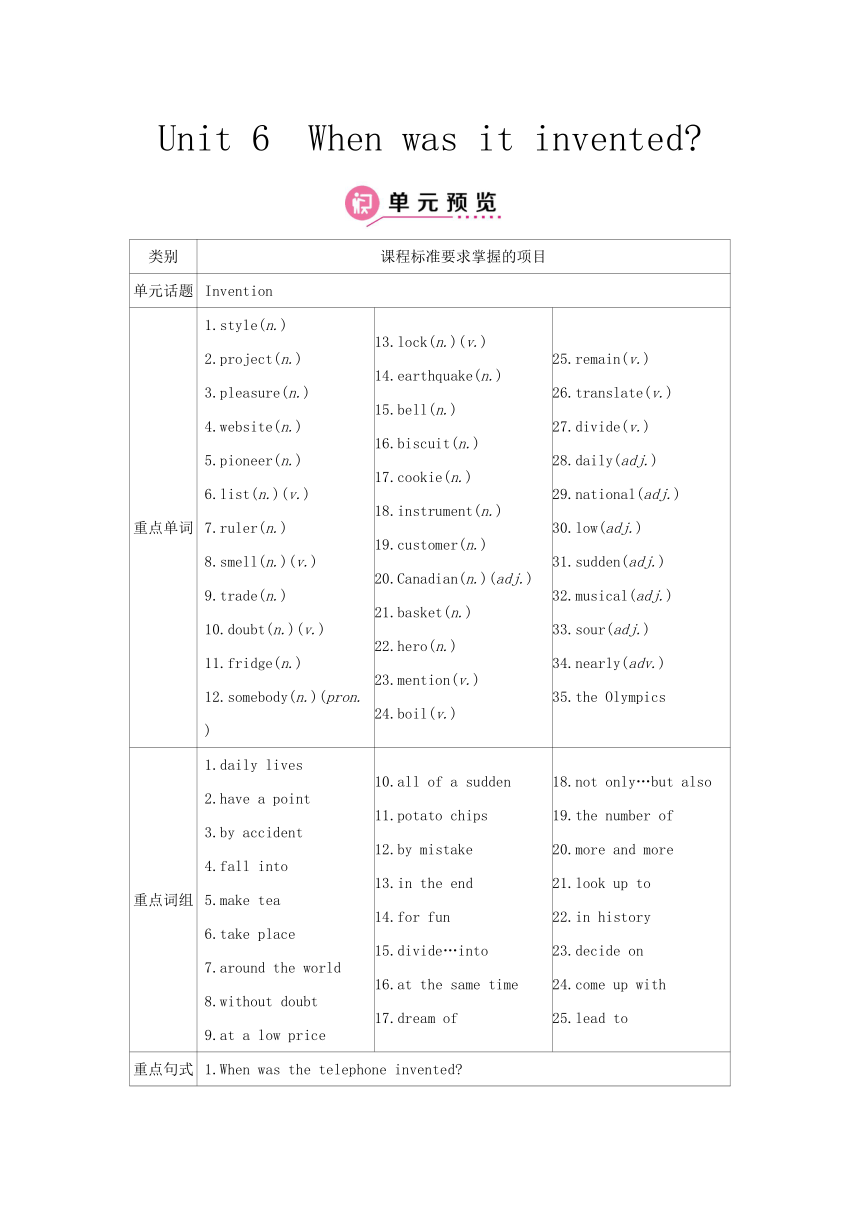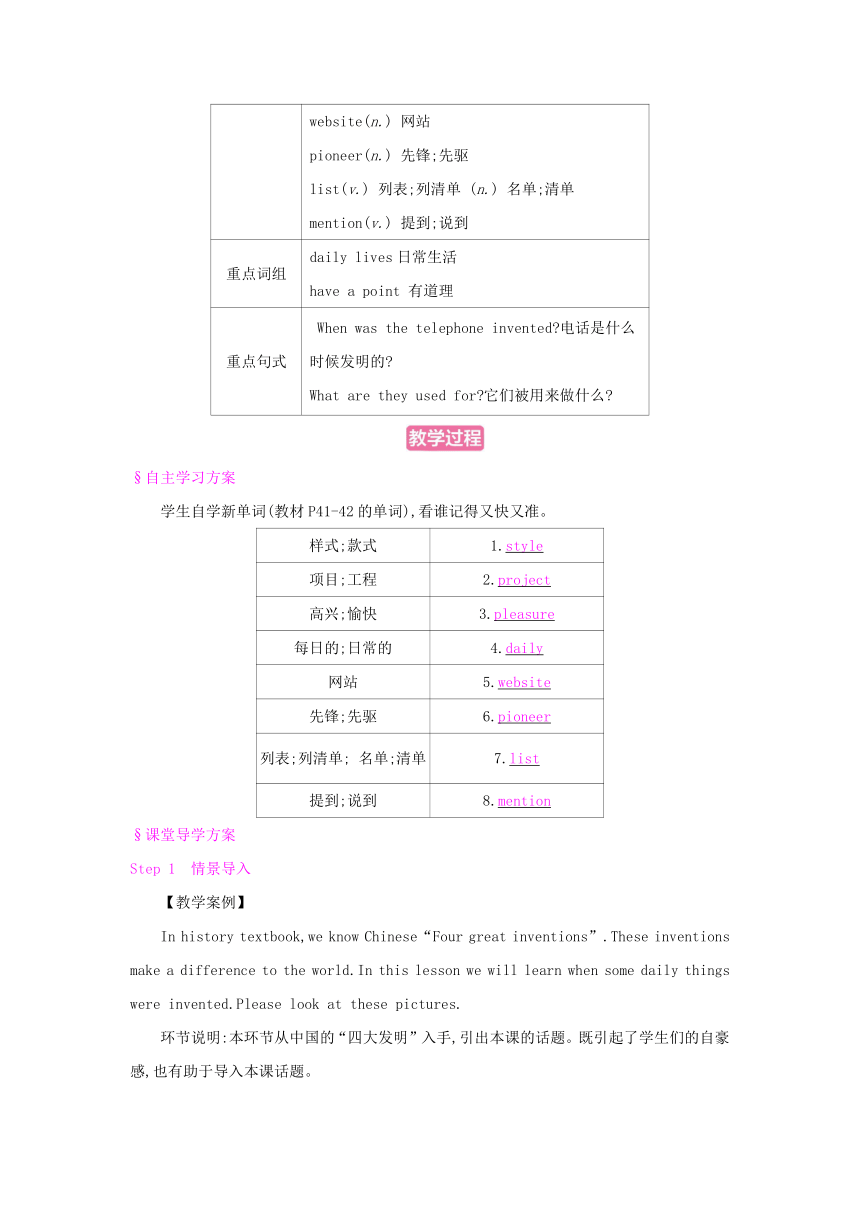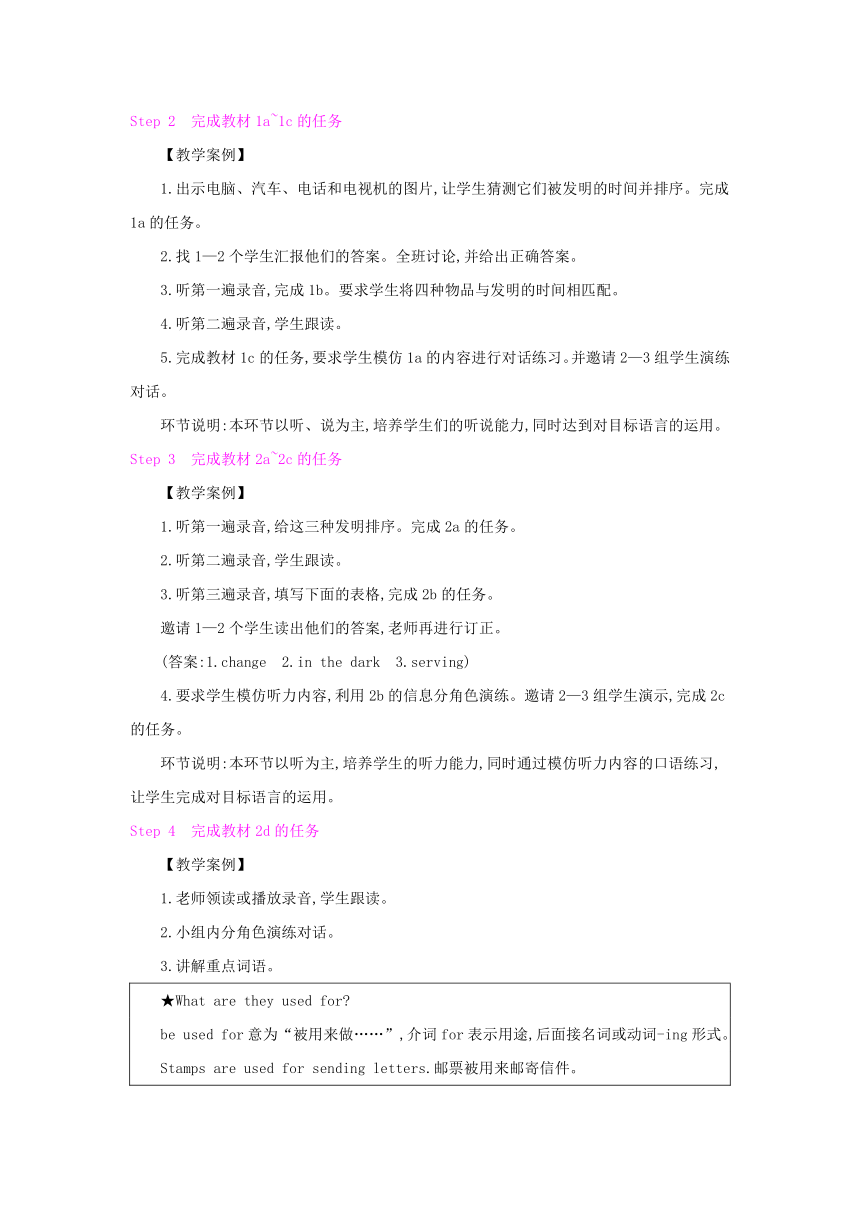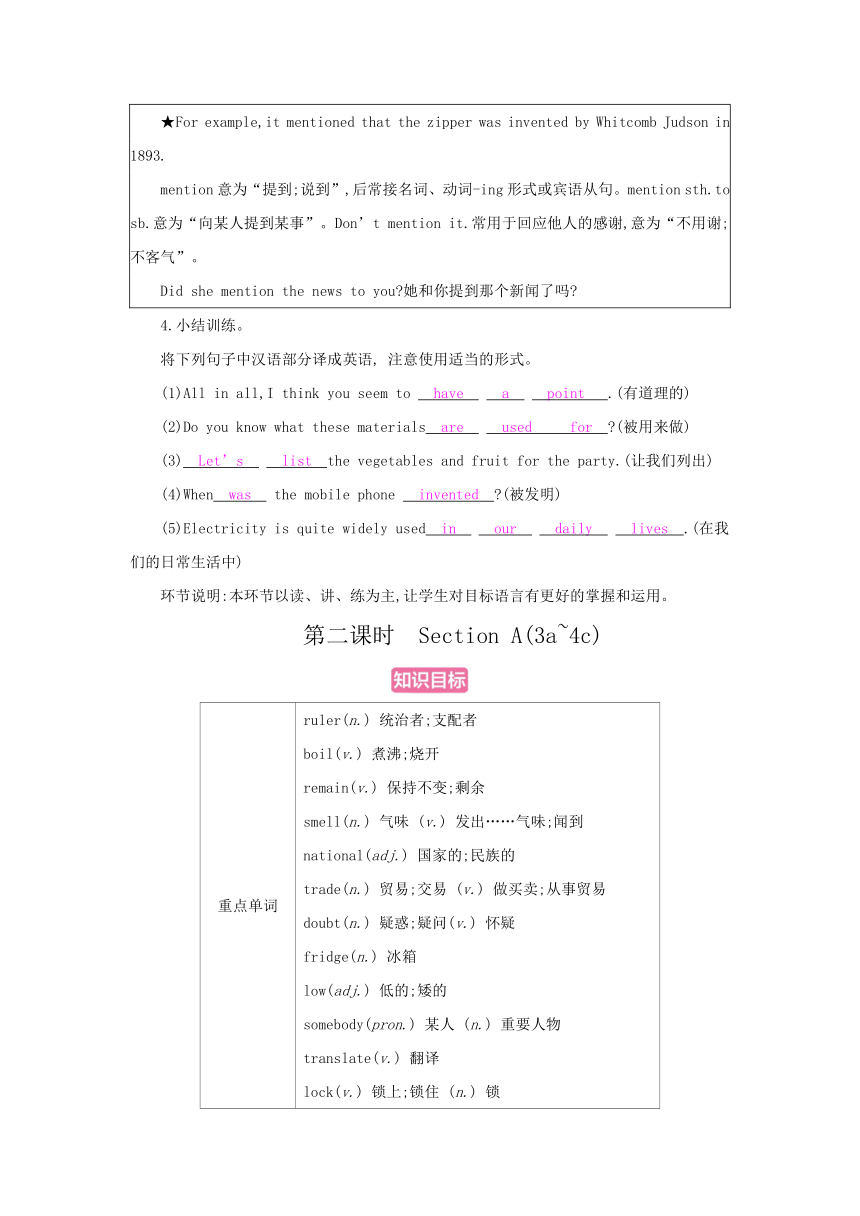Unit 6 When was it invented? 单元教学案(4课时)
文档属性
| 名称 | Unit 6 When was it invented? 单元教学案(4课时) |  | |
| 格式 | docx | ||
| 文件大小 | 80.6KB | ||
| 资源类型 | 教案 | ||
| 版本资源 | 人教新目标(Go for it)版 | ||
| 科目 | 英语 | ||
| 更新时间 | 2021-09-11 14:02:28 | ||
图片预览





文档简介
Unit
6
When
was
it
invented?
类别
课程标准要求掌握的项目
单元话题
Invention
重点单词
1.style(n.)
2.project(n.)
3.pleasure(n.)
4.website(n.)
5.pioneer(n.)
6.list(n.)(v.)
7.ruler(n.)
8.smell(n.)(v.)
9.trade(n.)
10.doubt(n.)(v.)
11.fridge(n.)
12.somebody(n.)(pron.)
13.lock(n.)(v.)
14.earthquake(n.)
15.bell(n.)
16.biscuit(n.)
17.cookie(n.)
18.instrument(n.)
19.customer(n.)
20.Canadian(n.)(adj.)
21.basket(n.)
22.hero(n.)
23.mention(v.)
24.boil(v.)
25.remain(v.)
26.translate(v.)
27.divide(v.)
28.daily(adj.)
29.national(adj.)
30.low(adj.)
31.sudden(adj.)
32.musical(adj.)
33.sour(adj.)
34.nearly(adv.)
35.the
Olympics
重点词组
1.daily
lives
2.have
a
point
3.by
accident
4.fall
into
5.make
tea
6.take
place
7.around
the
world
8.without
doubt
9.at
a
low
price
10.all
of
a
sudden
11.potato
chips
12.by
mistake
13.in
the
end
14.for
fun
15.divide…into
16.at
the
same
time
17.dream
of
18.not
only…but
also
19.the
number
of
20.more
and
more
21.look
up
to
22.in
history
23.decide
on
e
up
with
25.lead
to
重点句式
1.When
was
the
telephone
invented?
2.What
are
they
used
for?
3.Many
people
believe
that
tea
was
first
drunk
about
5,000
years
ago.
4.It
is
said
that
a
Chinese
ruler
called
Shen
Nong
was
the
first
to
discover
tea
as
a
drink.
5.It
produced
a
nice
smell
so
he
tasted
the
brown
water.
6.The
book
describes
how
tea
plants
were
grown
and
used
to
make
tea.
7.Potato
chips
were
invented
by
mistake.
8.George
wanted
to
make
the
customer
happy.
9.It
is
believed
that
the
first
basketball
game
in
history
was
played
on
December
21,1891.
10.Dr.Naismith
created
a
game
to
be
played
inside
on
a
hard
floor.
11.At
the
same
time,they
need
to
stop
the
competing
team
from
getting
the
ball
into
their
own
basket.
12.Basketball
has
not
only
become
a
popular
sport
to
play,but
it
has
also
become
a
popular
sport
to
watch.
13.The
number
of
foreign
players,including
Chinese
players,in
the
NBA
has
increased.
14.Many
young
people
look
up
to
these
basketball
heroes
and
want
to
become
like
them.
单元语法
一般过去时的被动语态
第一课时 Section
A(1a~2d)
重点单词
style(n.)
样式;款式
project(n.)
项目;工程
pleasure(n.)
高兴;愉快
daily(adj.)
每日的;日常的
website(n.)
网站
pioneer(n.)
先锋;先驱
list(v.)
列表;列清单
(n.)
名单;清单
mention(v.)
提到;说到
重点词组
daily
lives日常生活
have
a
point
有道理
重点句式
When
was
the
telephone
invented?电话是什么时候发明的?
What
are
they
used
for?它们被用来做什么?
§自主学习方案
学生自学新单词(教材P41-42的单词),看谁记得又快又准。
样式;款式
1.style
项目;工程
2.project
高兴;愉快
3.pleasure
每日的;日常的
4.daily
网站
5.website
先锋;先驱
6.pioneer
列表;列清单;
名单;清单
7.list
提到;说到
8.mention
§课堂导学方案
Step
1 情景导入
【教学案例】
In
history
textbook,we
know
Chinese“Four
great
inventions”.These
inventions
make
a
difference
to
the
world.In
this
lesson
we
will
learn
when
some
daily
things
were
invented.Please
look
at
these
pictures.
环节说明:本环节从中国的“四大发明”入手,引出本课的话题。既引起了学生们的自豪感,也有助于导入本课话题。
Step
2 完成教材1a~1c的任务
【教学案例】
1.出示电脑、汽车、电话和电视机的图片,让学生猜测它们被发明的时间并排序。完成1a的任务。
2.找1—2个学生汇报他们的答案。全班讨论,并给出正确答案。
3.听第一遍录音,完成1b。要求学生将四种物品与发明的时间相匹配。
4.听第二遍录音,学生跟读。
5.完成教材1c的任务,要求学生模仿1a的内容进行对话练习。并邀请2—3组学生演练对话。
环节说明:本环节以听、说为主,培养学生们的听说能力,同时达到对目标语言的运用。
Step
3 完成教材2a~2c的任务
【教学案例】
1.听第一遍录音,给这三种发明排序。完成2a的任务。
2.听第二遍录音,学生跟读。
3.听第三遍录音,填写下面的表格,完成2b的任务。
邀请1—2个学生读出他们的答案,老师再进行订正。
(答案:1.change 2.in
the
dark 3.serving)
4.要求学生模仿听力内容,利用2b的信息分角色演练。邀请2—3组学生演示,完成2c的任务。
环节说明:本环节以听为主,培养学生的听力能力,同时通过模仿听力内容的口语练习,让学生完成对目标语言的运用。
Step
4 完成教材2d的任务
【教学案例】
1.老师领读或播放录音,学生跟读。
2.小组内分角色演练对话。
3.讲解重点词语。
★What
are
they
used
for?
be
used
for意为“被用来做……”,介词for表示用途,后面接名词或动词-ing形式。
Stamps
are
used
for
sending
letters.邮票被用来邮寄信件。
★For
example,it
mentioned
that
the
zipper
was
invented
by
Whitcomb
Judson
in
1893.
mention意为“提到;说到”,后常接名词、动词-ing形式或宾语从句。mention
sth.to
sb.意为“向某人提到某事”。Don’t
mention
it.常用于回应他人的感谢,意为“不用谢;不客气”。
Did
she
mention
the
news
to
you?她和你提到那个新闻了吗?
4.小结训练。
将下列句子中汉语部分译成英语,
注意使用适当的形式。
(1)All
in
all,I
think
you
seem
to
have
a
point
.(有道理的)?
(2)Do
you
know
what
these
materials are
used
for ?(被用来做)?
(3) Let’s
list the
vegetables
and
fruit
for
the
party.(让我们列出)?
(4)When was
the
mobile
phone
invented ?(被发明)?
(5)Electricity
is
quite
widely
used in
our
daily
lives .(在我们的日常生活中)?
环节说明:本环节以读、讲、练为主,让学生对目标语言有更好的掌握和运用。
第二课时 Section
A(3a~4c)
重点单词
ruler(n.)
统治者;支配者
boil(v.)
煮沸;烧开
remain(v.)
保持不变;剩余
smell(n.)
气味
(v.)
发出……气味;闻到
national(adj.)
国家的;民族的
trade(n.)
贸易;交易
(v.)
做买卖;从事贸易
doubt(n.)
疑惑;疑问(v.)
怀疑
fridge(n.)
冰箱
low(adj.)
低的;矮的
somebody(pron.)
某人
(n.)
重要人物
translate(v.)
翻译
lock(v.)
锁上;锁住
(n.)
锁
earthquake(n.)
地震
sudden(adj.)
突然(的)
bell(n.)
钟(声);铃(声)
biscuit(n.)
饼干
cookie(n.)
曲奇饼
musical(adj.)
音乐的;有音乐天赋的
instrument
(n.)
器械;仪器;工具
重点词组
by
accident偶然;意外地
fall
into掉进
make
tea泡茶
take
place发生;出现
around
the
world全世界
without
doubt毫无疑问;的确
at
a
low
price以低价
all
of
a
sudden
突然;猛地
重点句式
Many
people
believe
that
tea
was
first
drunk
about
5,000
years
ago.许多人认为人们在大约5
000年前第一次喝茶。
It
is
said
that
a
Chinese
ruler
called
Shen
Nong
was
the
first
to
discover
tea
as
a
drink.据说有一位叫作神农的中国统治者最早发现了茶可以饮用。
It
produced
a
nice
smell
so
he
tasted
the
brown
water.它产生了一种好闻的味道,因此他尝了这种棕色的水。
The
book
describes
how
tea
plants
were
grown
and
used
to
make
tea.这本书描述了茶树怎样种植以及怎样泡茶。
§自主学习方案
学生自学新单词(教材P43-44的单词),看谁记得又快又准。
统治者;支配者
1.ruler
煮沸;烧开
2.boil
保持不变;剩余
3.remain
气味;发出……气味;闻到
4.smell
国家的;民族的
5.national
贸易;交易;
做买卖;
从事贸易
6.trade
疑惑;疑问;怀疑
7.doubt
冰箱
8.fridge
低的;矮的
9.low
某人;重要人物
10.somebody
翻译
11.translate
锁上;锁住;锁
12.lock
地震
13.earthquake
突然(的)
14.sudden
钟(声);铃(声)
15.bell
饼干
16.biscuit
音乐的;有
音乐天赋的
17.musical
器械;仪器;工具
18.instrument
§课堂导学方案
Step
1 情景导入
【教学案例】
本课时的主要内容是学习一篇小短文,在学习之前,准备几个与短文内容相关的问题,然后邀请几位学生就提出的问题给出自己的答案或见解。
1.Which
is
the
best
drink
in
the
world?
2.Who
invented
it?
环节说明:本环节用简单的问题引起学生的讨论,从而导入新课。
Step
2 完成教材3a~3c的任务
【教学案例】
1.默读课文,给课文的每个段落标上主旨大意。完成3a。
2.老师领读或听课文录音,学生跟读。
3.回答5个问题,完成3b。邀请1—2个学生读出自己的答案。然后老师和学生一起讨论答案。
4.用方框中所给动词的正确形式填空。完成3c。让学生在小组内讨论答案。
5.讲解重点句式和词语。
★It
is
said
that
a
Chinese
ruler
called
Shen
Nong
was
the
first
to
discover
tea
as
a
drink.
It
is
said
that…意为“据说……”,是英语中的一个常见句式。类似的结构还有:It
is
believed
that
…意为“人们认为……”;It
is
reported
that…意为“据报道……”;It
is
known
that
…意为
“众所周知……”。
★It
produced
a
nice
smell
so
he
tasted
the
brown
water.
(1)smell做名词,意为“气味”。
The
smells
from
the
kitchen
filled
the
room.来自厨房的味道充满了整个房间。
(2)smell做及物动词,意为“闻到”。
Can
you
smell
anything
unusual?你能闻到不寻常的气味吗?
(3)smell做系动词,意为“发出……气味”,后接形容词。
The
flowers
in
the
garden
smell
sweet.花园里的花发出芬芳的气味。
★The
tea
trade
from
China
to
Western
countries
took
place
in
the
19th
century.
take
place意为“发生;举行;出现”,不用于被动语态中。
The
sports
meeting
in
our
school
takes
place
in
December
every
year.每年十二月份我们学校都举行运动会。
环节说明:本环节以学生自学为主,老师给予帮助和引导,巩固学生对目标语言的理解和运用。
Step
3 完成教材Grammar
Focus的任务
【教学案例】
1.要求学生大声朗读表格内容。
2.要求学生总结出一般过去时的被动语态的构成形式。
3.找1-2个学生将这些句子翻译成汉语。
环节说明:本环节以学生自学为主,培养学生自主学习的能力,从而达到理解目标语言的目的。
Step
4 完成教材4a~4c的任务
【教学案例】
1.要求学生将下列句子变成含有被动语态的句子,写在练习本上。找1个学生在黑板上写出答案。老师订正答案。完成4a的任务。
2.用方框中所给动词的正确形式填空。完成4b的任务。
(答案:1.were
invited
2.were
brought
3.was
locked;rang 4.were
told;broke 5.were
eaten;liked)
3.用括号中所给动词的正确形式完成短文。完成4c的任务。
(答案:was
invented;was
born;worked;learned;was
invented;was
said;is
used)
4.小结训练。
将下列句子中汉语部分译成英语,注意使用适当的形式。
(1)Tom
is
without
doubt
one
of
the
finest
swimmers
in
the
school.(毫无疑问)?
(2)Great
changes have
taken
place in
our
country
during
the
past
ten
years.(发生)?
(3)I
really
don’t
know
whether
they
did
it
by
accident or
not.(偶然)?
(4)It
is
said
that
this
house
was
bought
by
a
young
man
at
a
low
price .(以低价)?
(5) All
of
a
sudden ,the
house
on
the
hill
caught
fire.(突然)?
环节说明:本环节以练为主,使学生对一般过去时的被动语态有更好的理解和运用。
第三课时 Section
B(1a~1e)
重点单词
sour(adj.)酸的;有酸味的
customer(n.)顾客;客户
重点词组
potato
chips薯片
by
mistake错误地;无意中
in
the
end最后
重点句式
Potato
chips
were
invented
by
mistake.薯片是无意中被发明的。
George
wanted
to
make
the
customer
happy.乔治想要让顾客高兴。
§自主学习方案
学生自学新单词(教材P45的单词),看谁记得又快又准。
脆的;酥脆的
1.crispy
咸的
2.salty
酸的;有酸味的
3.sour
顾客;客户
4.customer
§课堂导学方案
Step
1 情景导入
【教学案例】
在前面的课程中我们已经学习并了解了几种有用的发明,它们在很大程度上改变了我们的生活,使我们的生活更加丰富多彩。用几个问题来回顾一下。
1.What
do
you
think
is
the
most
useful
invention?
2.When
was
the
phone
invented?
3.Who
invented
tea?
4.Do
you
know
who
invented
potato
chips?
环节说明:本环节以问题的形式导入新课,既复习了学过的内容,又引出了新课内容。
Step
2 完成教材1a~1d的任务
【教学案例】
1.用方框中所给的词语来描述4幅图片中食物的味道。让学生们在小组内讨论一下。完成1a的任务。
2.给下列4个形容词再列举出一种不同的食物。让学生们在小组内讨论一下。完成1b的任务。
3.听两遍录音,完成1c的任务。
4.再听一遍录音,完成1d的任务。
5.大声朗读录音材料。
6.再听一遍录音,学生跟读。
环节说明:本环节以听为主,训练学生听的能力,对目标语言有更好的理解和运用。
Step
3 完成教材1e的任务
【教学案例】
1.放下录音材料,要求学生利用1c的听力内容,模仿1e方框中所给的对话编写一个有关薯片的发明的对话练习。在小组内交流所写内容。
2.邀请2—3组学生演练所写对话。
3.小结训练。
根据句意,用括号中所给单词的适当形式填空。
(1) Finally
they
got
to
the
village.(final)?
(2)The
soup
was
not salty
enough.(salt)?
(3)Paper
is
one
of
the
four
great inventions
of
ancient
China.(invent)
?
(4)The
potato
chips
were
invented
by
a
cook called
George
Crum.(call)?
(5)We
were really
nervous
because
of
the
exam.We
tried
to
keep
calm
(镇静).(real)
?
环节说明:本环节以写、说为主,培养学生对目标语言的运用能力。
第四课时 Section
B(2a~Self
Check)
重点单词
the
Olympics奥林匹克运动会
Canadian(adj.)
加拿大的;加拿大人的
(n.)
加拿大人
divide(v.)分开;分散
basket(n.)
篮;筐
hero(n.)
英雄;男主角
重点词组
for
fun开玩笑地
divide…into把……分开
at
the
same
time同时
dream
of梦见
not
only…but
also…不仅……而且……
the
number
of……的数量
more
and
more越来越
look
up
to钦佩;仰慕
in
history在历史上
decide
on决定;选定
come
up
with想出
lead
to
导致;通向
重点句式
It
is
believed
that
the
first
basketball
game
in
history
was
played
on
December
21,1891.据说历史上的第一场篮球赛在1891年12月21日举行。
Dr.Naismith
created
a
game
to
be
played
inside
on
a
hard
floor.奈史密斯博士创造了一个在室内坚硬的地板上玩的游戏。
At
the
same
time,they
need
to
stop
the
competing
team
from
getting
the
ball
into
their
own
basket.同时,他们需要阻止参赛的球队投球进他们自己的篮筐里。
Basketball
has
not
only
become
a
popular
sport
to
play,but
it
has
also
become
a
popular
sport
to
watch.篮球不仅成了一种流行的运动,而且也变成了可观赏的流行的运动。
The
number
of
foreign
players,including
Chinese
players,in
the
NBA
has
increased.在NBA中的外国球员的数量有所增加,其中也包括中国球员。
Many
young
people
look
up
to
these
basketball
heroes
and
want
to
become
like
them.许多年轻人钦佩这些篮球英雄,想要成为像他们一样的人。
§自主学习方案
学生自学新单词(教材P46-48的单词),看谁记得又快又准。
奥林匹克运动会
1.the
Olympics
加拿大的;加拿大人的;加拿大人
2.Canadian
分开;分散
3.divide
篮;筐
4.basket
英雄;男主角
5.hero
§课堂导学方案
Step
1 情景导入
【教学案例】
本课时的主要内容是学习一篇关于篮球发展历史的短文。老师可以准备几个与短文内容相关的问题,然后邀请几位学生就提出的问题给出自己的答案。
1.Do
you
like
basketball?
2.Do
you
know
who
invented
basketball?
3.Who
is
the
greatest
basketball
star
in
China?
环节说明:本环节以问题讨论的方式入手,自然导入新课。让学生带着问题阅读课文。
Step
2 完成教材2a~2e的任务
【教学案例】
1.要求学生默读课文,找出每个段落的主旨大意。完成2b的任务。
2.老师领读或播放课文录音,学生跟读。
3.要求学生再次默读课文,完成2c的任务。用课文中的信息,完成思维导图。要求学生在小组内讨论答案。
4.要求学生在小组内回答这5个问题,完成2d的任务。邀请1—2个学生读出答案。
5.要求学生在小组内讨论成为一个著名的篮球运动员有哪些困难和好的事情。邀请1—2个学生回答这个问题。
6.讲解重点句式和词语。
★At
the
same
time,they
need
to
stop
the
competing
team
from
getting
the
ball
into
their
own
basket.
stop…(from)
doing
sth.意为“阻止……做某事”,相当于prevent/keep…from
doing
sth.。
All
the
climbers
were
stopped
from
going
up
the
mountain
because
of
the
storm.因为暴风雨的原因,所有登山者都被禁止登山。
★Dr.
Naismith
divided
the
men
in
his
class
into
two
teams
and
taught
them
to
play
his
new
game.
divide…into意为“把……分成”,侧重把某个整体划分为若干部分。
A
year
has
four
seasons
and
it
is
divided
into
twelve
months.一年有四季,分为十二个月。
★Basketball
has
not
only
become
a
popular
sport
to
play,but
it
has
also
become
a
popular
sport
to
watch.
not
only…but
also
…意为“不但/不仅……而且……”,连接两个并列成分,如主语、谓语、宾语、表语、状语等,但所强调的重点是后面的部分。当not
only…but
(also)…连接两个主语时,遵循就近原则,谓语动词与后面的主语在人称和数上保持一致。
Not
only
her
parents
but
also
she
herself
likes
this
house.不仅她的父母,而且她自己也喜欢这个房子。
★Many
young
people
look
up
to
these
basketball
heroes
and
want
to
become
like
them.
look
up
to意为“钦佩;仰慕”。
The
children
all
look
up
to
the
baseball
player.孩子们都钦佩这名棒球运动员。
7.小结训练。
将下列句子中汉语部分译成英语,
注意使用适当的形式。
(1)Maybe
someone
has
taken
your
bag by
mistake .(错误)?
(2)My
sister
can not
only
sing
but
also
dance.(不但……而且……)?
(3)Can
you divide
this
cake
into
five
pieces
with
two
cuts?(把……分成)?
(4)Nearly
each
boy looks
up
to
soccer
stars.(崇拜)?
(5)This
kind
of
knife is
used
for
cutting
meat.(被用来)?
环节说明:本环节以学生自学为主,老师引导为辅,培养学生的自学能力,激发学生的学习兴趣。
Step
3 完成教材3a~Self
Check的任务
【教学案例】
1.要求学生想一件不愿意做的事情。然后想出一个可以帮助他们的发明。按照3a的列表填写出来。完成3a的任务。
2.假如你是一名商人,描述一下你的新发明,并且设法把这个发明卖出去。请写一篇短文介绍这个发明,仿照3b中的叙述。
3.用方框中所给单词的正确形式填空,完成1。
(答案:invent;all
of
a
sudden;doubt;websites;mention)
4.用被动语态改写下面的句子。完成2。
5.查找你想要更多地了解的一种发明的信息,用下面的提示写出句子。完成3。
环节说明:本环节针对本单元的主要目标语言进行训练,巩固学生对目标语言的学习和运用。
6
When
was
it
invented?
类别
课程标准要求掌握的项目
单元话题
Invention
重点单词
1.style(n.)
2.project(n.)
3.pleasure(n.)
4.website(n.)
5.pioneer(n.)
6.list(n.)(v.)
7.ruler(n.)
8.smell(n.)(v.)
9.trade(n.)
10.doubt(n.)(v.)
11.fridge(n.)
12.somebody(n.)(pron.)
13.lock(n.)(v.)
14.earthquake(n.)
15.bell(n.)
16.biscuit(n.)
17.cookie(n.)
18.instrument(n.)
19.customer(n.)
20.Canadian(n.)(adj.)
21.basket(n.)
22.hero(n.)
23.mention(v.)
24.boil(v.)
25.remain(v.)
26.translate(v.)
27.divide(v.)
28.daily(adj.)
29.national(adj.)
30.low(adj.)
31.sudden(adj.)
32.musical(adj.)
33.sour(adj.)
34.nearly(adv.)
35.the
Olympics
重点词组
1.daily
lives
2.have
a
point
3.by
accident
4.fall
into
5.make
tea
6.take
place
7.around
the
world
8.without
doubt
9.at
a
low
price
10.all
of
a
sudden
11.potato
chips
12.by
mistake
13.in
the
end
14.for
fun
15.divide…into
16.at
the
same
time
17.dream
of
18.not
only…but
also
19.the
number
of
20.more
and
more
21.look
up
to
22.in
history
23.decide
on
e
up
with
25.lead
to
重点句式
1.When
was
the
telephone
invented?
2.What
are
they
used
for?
3.Many
people
believe
that
tea
was
first
drunk
about
5,000
years
ago.
4.It
is
said
that
a
Chinese
ruler
called
Shen
Nong
was
the
first
to
discover
tea
as
a
drink.
5.It
produced
a
nice
smell
so
he
tasted
the
brown
water.
6.The
book
describes
how
tea
plants
were
grown
and
used
to
make
tea.
7.Potato
chips
were
invented
by
mistake.
8.George
wanted
to
make
the
customer
happy.
9.It
is
believed
that
the
first
basketball
game
in
history
was
played
on
December
21,1891.
10.Dr.Naismith
created
a
game
to
be
played
inside
on
a
hard
floor.
11.At
the
same
time,they
need
to
stop
the
competing
team
from
getting
the
ball
into
their
own
basket.
12.Basketball
has
not
only
become
a
popular
sport
to
play,but
it
has
also
become
a
popular
sport
to
watch.
13.The
number
of
foreign
players,including
Chinese
players,in
the
NBA
has
increased.
14.Many
young
people
look
up
to
these
basketball
heroes
and
want
to
become
like
them.
单元语法
一般过去时的被动语态
第一课时 Section
A(1a~2d)
重点单词
style(n.)
样式;款式
project(n.)
项目;工程
pleasure(n.)
高兴;愉快
daily(adj.)
每日的;日常的
website(n.)
网站
pioneer(n.)
先锋;先驱
list(v.)
列表;列清单
(n.)
名单;清单
mention(v.)
提到;说到
重点词组
daily
lives日常生活
have
a
point
有道理
重点句式
When
was
the
telephone
invented?电话是什么时候发明的?
What
are
they
used
for?它们被用来做什么?
§自主学习方案
学生自学新单词(教材P41-42的单词),看谁记得又快又准。
样式;款式
1.style
项目;工程
2.project
高兴;愉快
3.pleasure
每日的;日常的
4.daily
网站
5.website
先锋;先驱
6.pioneer
列表;列清单;
名单;清单
7.list
提到;说到
8.mention
§课堂导学方案
Step
1 情景导入
【教学案例】
In
history
textbook,we
know
Chinese“Four
great
inventions”.These
inventions
make
a
difference
to
the
world.In
this
lesson
we
will
learn
when
some
daily
things
were
invented.Please
look
at
these
pictures.
环节说明:本环节从中国的“四大发明”入手,引出本课的话题。既引起了学生们的自豪感,也有助于导入本课话题。
Step
2 完成教材1a~1c的任务
【教学案例】
1.出示电脑、汽车、电话和电视机的图片,让学生猜测它们被发明的时间并排序。完成1a的任务。
2.找1—2个学生汇报他们的答案。全班讨论,并给出正确答案。
3.听第一遍录音,完成1b。要求学生将四种物品与发明的时间相匹配。
4.听第二遍录音,学生跟读。
5.完成教材1c的任务,要求学生模仿1a的内容进行对话练习。并邀请2—3组学生演练对话。
环节说明:本环节以听、说为主,培养学生们的听说能力,同时达到对目标语言的运用。
Step
3 完成教材2a~2c的任务
【教学案例】
1.听第一遍录音,给这三种发明排序。完成2a的任务。
2.听第二遍录音,学生跟读。
3.听第三遍录音,填写下面的表格,完成2b的任务。
邀请1—2个学生读出他们的答案,老师再进行订正。
(答案:1.change 2.in
the
dark 3.serving)
4.要求学生模仿听力内容,利用2b的信息分角色演练。邀请2—3组学生演示,完成2c的任务。
环节说明:本环节以听为主,培养学生的听力能力,同时通过模仿听力内容的口语练习,让学生完成对目标语言的运用。
Step
4 完成教材2d的任务
【教学案例】
1.老师领读或播放录音,学生跟读。
2.小组内分角色演练对话。
3.讲解重点词语。
★What
are
they
used
for?
be
used
for意为“被用来做……”,介词for表示用途,后面接名词或动词-ing形式。
Stamps
are
used
for
sending
letters.邮票被用来邮寄信件。
★For
example,it
mentioned
that
the
zipper
was
invented
by
Whitcomb
Judson
in
1893.
mention意为“提到;说到”,后常接名词、动词-ing形式或宾语从句。mention
sth.to
sb.意为“向某人提到某事”。Don’t
mention
it.常用于回应他人的感谢,意为“不用谢;不客气”。
Did
she
mention
the
news
to
you?她和你提到那个新闻了吗?
4.小结训练。
将下列句子中汉语部分译成英语,
注意使用适当的形式。
(1)All
in
all,I
think
you
seem
to
have
a
point
.(有道理的)?
(2)Do
you
know
what
these
materials are
used
for ?(被用来做)?
(3) Let’s
list the
vegetables
and
fruit
for
the
party.(让我们列出)?
(4)When was
the
mobile
phone
invented ?(被发明)?
(5)Electricity
is
quite
widely
used in
our
daily
lives .(在我们的日常生活中)?
环节说明:本环节以读、讲、练为主,让学生对目标语言有更好的掌握和运用。
第二课时 Section
A(3a~4c)
重点单词
ruler(n.)
统治者;支配者
boil(v.)
煮沸;烧开
remain(v.)
保持不变;剩余
smell(n.)
气味
(v.)
发出……气味;闻到
national(adj.)
国家的;民族的
trade(n.)
贸易;交易
(v.)
做买卖;从事贸易
doubt(n.)
疑惑;疑问(v.)
怀疑
fridge(n.)
冰箱
low(adj.)
低的;矮的
somebody(pron.)
某人
(n.)
重要人物
translate(v.)
翻译
lock(v.)
锁上;锁住
(n.)
锁
earthquake(n.)
地震
sudden(adj.)
突然(的)
bell(n.)
钟(声);铃(声)
biscuit(n.)
饼干
cookie(n.)
曲奇饼
musical(adj.)
音乐的;有音乐天赋的
instrument
(n.)
器械;仪器;工具
重点词组
by
accident偶然;意外地
fall
into掉进
make
tea泡茶
take
place发生;出现
around
the
world全世界
without
doubt毫无疑问;的确
at
a
low
price以低价
all
of
a
sudden
突然;猛地
重点句式
Many
people
believe
that
tea
was
first
drunk
about
5,000
years
ago.许多人认为人们在大约5
000年前第一次喝茶。
It
is
said
that
a
Chinese
ruler
called
Shen
Nong
was
the
first
to
discover
tea
as
a
drink.据说有一位叫作神农的中国统治者最早发现了茶可以饮用。
It
produced
a
nice
smell
so
he
tasted
the
brown
water.它产生了一种好闻的味道,因此他尝了这种棕色的水。
The
book
describes
how
tea
plants
were
grown
and
used
to
make
tea.这本书描述了茶树怎样种植以及怎样泡茶。
§自主学习方案
学生自学新单词(教材P43-44的单词),看谁记得又快又准。
统治者;支配者
1.ruler
煮沸;烧开
2.boil
保持不变;剩余
3.remain
气味;发出……气味;闻到
4.smell
国家的;民族的
5.national
贸易;交易;
做买卖;
从事贸易
6.trade
疑惑;疑问;怀疑
7.doubt
冰箱
8.fridge
低的;矮的
9.low
某人;重要人物
10.somebody
翻译
11.translate
锁上;锁住;锁
12.lock
地震
13.earthquake
突然(的)
14.sudden
钟(声);铃(声)
15.bell
饼干
16.biscuit
音乐的;有
音乐天赋的
17.musical
器械;仪器;工具
18.instrument
§课堂导学方案
Step
1 情景导入
【教学案例】
本课时的主要内容是学习一篇小短文,在学习之前,准备几个与短文内容相关的问题,然后邀请几位学生就提出的问题给出自己的答案或见解。
1.Which
is
the
best
drink
in
the
world?
2.Who
invented
it?
环节说明:本环节用简单的问题引起学生的讨论,从而导入新课。
Step
2 完成教材3a~3c的任务
【教学案例】
1.默读课文,给课文的每个段落标上主旨大意。完成3a。
2.老师领读或听课文录音,学生跟读。
3.回答5个问题,完成3b。邀请1—2个学生读出自己的答案。然后老师和学生一起讨论答案。
4.用方框中所给动词的正确形式填空。完成3c。让学生在小组内讨论答案。
5.讲解重点句式和词语。
★It
is
said
that
a
Chinese
ruler
called
Shen
Nong
was
the
first
to
discover
tea
as
a
drink.
It
is
said
that…意为“据说……”,是英语中的一个常见句式。类似的结构还有:It
is
believed
that
…意为“人们认为……”;It
is
reported
that…意为“据报道……”;It
is
known
that
…意为
“众所周知……”。
★It
produced
a
nice
smell
so
he
tasted
the
brown
water.
(1)smell做名词,意为“气味”。
The
smells
from
the
kitchen
filled
the
room.来自厨房的味道充满了整个房间。
(2)smell做及物动词,意为“闻到”。
Can
you
smell
anything
unusual?你能闻到不寻常的气味吗?
(3)smell做系动词,意为“发出……气味”,后接形容词。
The
flowers
in
the
garden
smell
sweet.花园里的花发出芬芳的气味。
★The
tea
trade
from
China
to
Western
countries
took
place
in
the
19th
century.
take
place意为“发生;举行;出现”,不用于被动语态中。
The
sports
meeting
in
our
school
takes
place
in
December
every
year.每年十二月份我们学校都举行运动会。
环节说明:本环节以学生自学为主,老师给予帮助和引导,巩固学生对目标语言的理解和运用。
Step
3 完成教材Grammar
Focus的任务
【教学案例】
1.要求学生大声朗读表格内容。
2.要求学生总结出一般过去时的被动语态的构成形式。
3.找1-2个学生将这些句子翻译成汉语。
环节说明:本环节以学生自学为主,培养学生自主学习的能力,从而达到理解目标语言的目的。
Step
4 完成教材4a~4c的任务
【教学案例】
1.要求学生将下列句子变成含有被动语态的句子,写在练习本上。找1个学生在黑板上写出答案。老师订正答案。完成4a的任务。
2.用方框中所给动词的正确形式填空。完成4b的任务。
(答案:1.were
invited
2.were
brought
3.was
locked;rang 4.were
told;broke 5.were
eaten;liked)
3.用括号中所给动词的正确形式完成短文。完成4c的任务。
(答案:was
invented;was
born;worked;learned;was
invented;was
said;is
used)
4.小结训练。
将下列句子中汉语部分译成英语,注意使用适当的形式。
(1)Tom
is
without
doubt
one
of
the
finest
swimmers
in
the
school.(毫无疑问)?
(2)Great
changes have
taken
place in
our
country
during
the
past
ten
years.(发生)?
(3)I
really
don’t
know
whether
they
did
it
by
accident or
not.(偶然)?
(4)It
is
said
that
this
house
was
bought
by
a
young
man
at
a
low
price .(以低价)?
(5) All
of
a
sudden ,the
house
on
the
hill
caught
fire.(突然)?
环节说明:本环节以练为主,使学生对一般过去时的被动语态有更好的理解和运用。
第三课时 Section
B(1a~1e)
重点单词
sour(adj.)酸的;有酸味的
customer(n.)顾客;客户
重点词组
potato
chips薯片
by
mistake错误地;无意中
in
the
end最后
重点句式
Potato
chips
were
invented
by
mistake.薯片是无意中被发明的。
George
wanted
to
make
the
customer
happy.乔治想要让顾客高兴。
§自主学习方案
学生自学新单词(教材P45的单词),看谁记得又快又准。
脆的;酥脆的
1.crispy
咸的
2.salty
酸的;有酸味的
3.sour
顾客;客户
4.customer
§课堂导学方案
Step
1 情景导入
【教学案例】
在前面的课程中我们已经学习并了解了几种有用的发明,它们在很大程度上改变了我们的生活,使我们的生活更加丰富多彩。用几个问题来回顾一下。
1.What
do
you
think
is
the
most
useful
invention?
2.When
was
the
phone
invented?
3.Who
invented
tea?
4.Do
you
know
who
invented
potato
chips?
环节说明:本环节以问题的形式导入新课,既复习了学过的内容,又引出了新课内容。
Step
2 完成教材1a~1d的任务
【教学案例】
1.用方框中所给的词语来描述4幅图片中食物的味道。让学生们在小组内讨论一下。完成1a的任务。
2.给下列4个形容词再列举出一种不同的食物。让学生们在小组内讨论一下。完成1b的任务。
3.听两遍录音,完成1c的任务。
4.再听一遍录音,完成1d的任务。
5.大声朗读录音材料。
6.再听一遍录音,学生跟读。
环节说明:本环节以听为主,训练学生听的能力,对目标语言有更好的理解和运用。
Step
3 完成教材1e的任务
【教学案例】
1.放下录音材料,要求学生利用1c的听力内容,模仿1e方框中所给的对话编写一个有关薯片的发明的对话练习。在小组内交流所写内容。
2.邀请2—3组学生演练所写对话。
3.小结训练。
根据句意,用括号中所给单词的适当形式填空。
(1) Finally
they
got
to
the
village.(final)?
(2)The
soup
was
not salty
enough.(salt)?
(3)Paper
is
one
of
the
four
great inventions
of
ancient
China.(invent)
?
(4)The
potato
chips
were
invented
by
a
cook called
George
Crum.(call)?
(5)We
were really
nervous
because
of
the
exam.We
tried
to
keep
calm
(镇静).(real)
?
环节说明:本环节以写、说为主,培养学生对目标语言的运用能力。
第四课时 Section
B(2a~Self
Check)
重点单词
the
Olympics奥林匹克运动会
Canadian(adj.)
加拿大的;加拿大人的
(n.)
加拿大人
divide(v.)分开;分散
basket(n.)
篮;筐
hero(n.)
英雄;男主角
重点词组
for
fun开玩笑地
divide…into把……分开
at
the
same
time同时
dream
of梦见
not
only…but
also…不仅……而且……
the
number
of……的数量
more
and
more越来越
look
up
to钦佩;仰慕
in
history在历史上
decide
on决定;选定
come
up
with想出
lead
to
导致;通向
重点句式
It
is
believed
that
the
first
basketball
game
in
history
was
played
on
December
21,1891.据说历史上的第一场篮球赛在1891年12月21日举行。
Dr.Naismith
created
a
game
to
be
played
inside
on
a
hard
floor.奈史密斯博士创造了一个在室内坚硬的地板上玩的游戏。
At
the
same
time,they
need
to
stop
the
competing
team
from
getting
the
ball
into
their
own
basket.同时,他们需要阻止参赛的球队投球进他们自己的篮筐里。
Basketball
has
not
only
become
a
popular
sport
to
play,but
it
has
also
become
a
popular
sport
to
watch.篮球不仅成了一种流行的运动,而且也变成了可观赏的流行的运动。
The
number
of
foreign
players,including
Chinese
players,in
the
NBA
has
increased.在NBA中的外国球员的数量有所增加,其中也包括中国球员。
Many
young
people
look
up
to
these
basketball
heroes
and
want
to
become
like
them.许多年轻人钦佩这些篮球英雄,想要成为像他们一样的人。
§自主学习方案
学生自学新单词(教材P46-48的单词),看谁记得又快又准。
奥林匹克运动会
1.the
Olympics
加拿大的;加拿大人的;加拿大人
2.Canadian
分开;分散
3.divide
篮;筐
4.basket
英雄;男主角
5.hero
§课堂导学方案
Step
1 情景导入
【教学案例】
本课时的主要内容是学习一篇关于篮球发展历史的短文。老师可以准备几个与短文内容相关的问题,然后邀请几位学生就提出的问题给出自己的答案。
1.Do
you
like
basketball?
2.Do
you
know
who
invented
basketball?
3.Who
is
the
greatest
basketball
star
in
China?
环节说明:本环节以问题讨论的方式入手,自然导入新课。让学生带着问题阅读课文。
Step
2 完成教材2a~2e的任务
【教学案例】
1.要求学生默读课文,找出每个段落的主旨大意。完成2b的任务。
2.老师领读或播放课文录音,学生跟读。
3.要求学生再次默读课文,完成2c的任务。用课文中的信息,完成思维导图。要求学生在小组内讨论答案。
4.要求学生在小组内回答这5个问题,完成2d的任务。邀请1—2个学生读出答案。
5.要求学生在小组内讨论成为一个著名的篮球运动员有哪些困难和好的事情。邀请1—2个学生回答这个问题。
6.讲解重点句式和词语。
★At
the
same
time,they
need
to
stop
the
competing
team
from
getting
the
ball
into
their
own
basket.
stop…(from)
doing
sth.意为“阻止……做某事”,相当于prevent/keep…from
doing
sth.。
All
the
climbers
were
stopped
from
going
up
the
mountain
because
of
the
storm.因为暴风雨的原因,所有登山者都被禁止登山。
★Dr.
Naismith
divided
the
men
in
his
class
into
two
teams
and
taught
them
to
play
his
new
game.
divide…into意为“把……分成”,侧重把某个整体划分为若干部分。
A
year
has
four
seasons
and
it
is
divided
into
twelve
months.一年有四季,分为十二个月。
★Basketball
has
not
only
become
a
popular
sport
to
play,but
it
has
also
become
a
popular
sport
to
watch.
not
only…but
also
…意为“不但/不仅……而且……”,连接两个并列成分,如主语、谓语、宾语、表语、状语等,但所强调的重点是后面的部分。当not
only…but
(also)…连接两个主语时,遵循就近原则,谓语动词与后面的主语在人称和数上保持一致。
Not
only
her
parents
but
also
she
herself
likes
this
house.不仅她的父母,而且她自己也喜欢这个房子。
★Many
young
people
look
up
to
these
basketball
heroes
and
want
to
become
like
them.
look
up
to意为“钦佩;仰慕”。
The
children
all
look
up
to
the
baseball
player.孩子们都钦佩这名棒球运动员。
7.小结训练。
将下列句子中汉语部分译成英语,
注意使用适当的形式。
(1)Maybe
someone
has
taken
your
bag by
mistake .(错误)?
(2)My
sister
can not
only
sing
but
also
dance.(不但……而且……)?
(3)Can
you divide
this
cake
into
five
pieces
with
two
cuts?(把……分成)?
(4)Nearly
each
boy looks
up
to
soccer
stars.(崇拜)?
(5)This
kind
of
knife is
used
for
cutting
meat.(被用来)?
环节说明:本环节以学生自学为主,老师引导为辅,培养学生的自学能力,激发学生的学习兴趣。
Step
3 完成教材3a~Self
Check的任务
【教学案例】
1.要求学生想一件不愿意做的事情。然后想出一个可以帮助他们的发明。按照3a的列表填写出来。完成3a的任务。
2.假如你是一名商人,描述一下你的新发明,并且设法把这个发明卖出去。请写一篇短文介绍这个发明,仿照3b中的叙述。
3.用方框中所给单词的正确形式填空,完成1。
(答案:invent;all
of
a
sudden;doubt;websites;mention)
4.用被动语态改写下面的句子。完成2。
5.查找你想要更多地了解的一种发明的信息,用下面的提示写出句子。完成3。
环节说明:本环节针对本单元的主要目标语言进行训练,巩固学生对目标语言的学习和运用。
同课章节目录
- Unit 1 How can we become good learners.
- Section A
- Section B
- Unit 2 I think that mooncakes are delicious!
- Section A
- Section B
- Unit 3 Could you please tell me where the restroom
- Section A
- Section B
- Unit 4 I used to be afraid of the dark.
- Section A
- Section B
- Unit 5 What are the shirts made of?
- Section A
- Section B
- Review of Units 1-5
- Unit 6 When was it invented?
- Section A
- Section B
- Unit 7 Teenagers should be allowed to choose their
- Section A
- Section B
- Unit 8 It must belong to Carla.
- Section A
- Section B
- Unit 9 I like music that I can dance to.
- Section A
- Section B
- Unit 10 You're supposed to shake hands.
- Section A
- Section B
- Review of Units 6-10
- Unit 11 Sad movies make me cry.
- Section A
- Section B
- Unit 12 Life is full of the unexpected
- Section A
- Section B
- Unit 13 We're trying to save the earth!
- Section A
- Section B
- Unit 14 I remember meeting all of you in Grade 7.
- Section A
- Section B
- Review of Units 11-14
